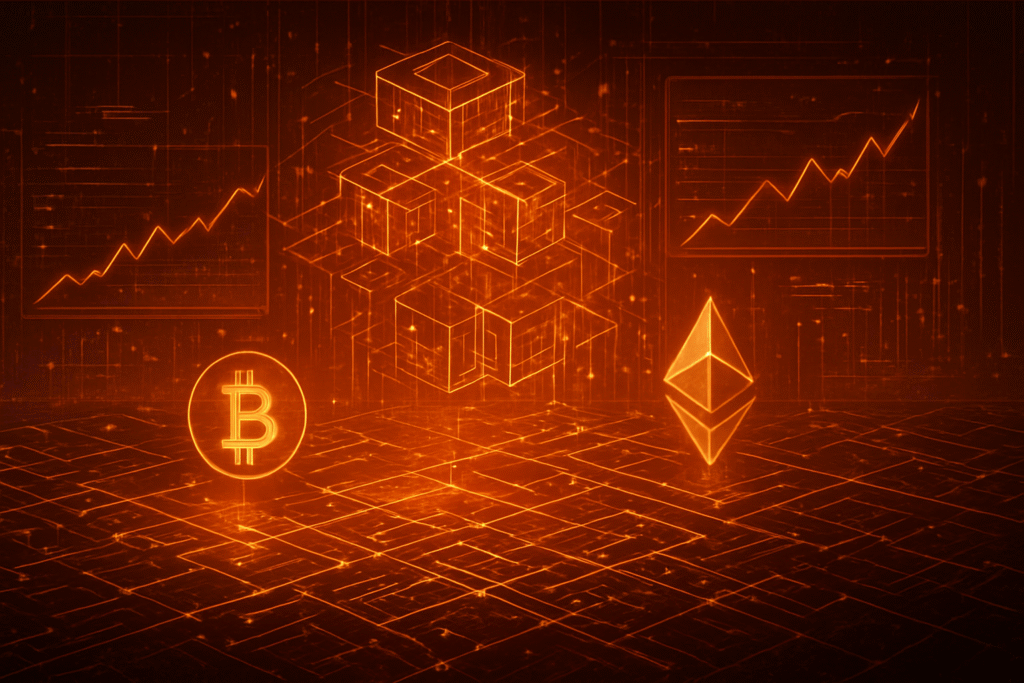
The cryptocurrency ecosystem is experiencing a profound transformation, with decentralized applications (dApps) increasingly generating more revenue than their underlying blockchain infrastructures. This pivotal shift, which became significantly apparent throughout 2024 and intensified into 2025, signals a maturation of the industry, moving from a focus on foundational infrastructure to one driven by utility-rich applications. Data from the first quarter of 2025 revealed that dApps collectively generated an impressive $1.8 billion in total fee revenue, surpassing the $1.4 billion earned by infrastructure protocols during the same period. More strikingly, in the first half of 2025, DeFi and finance applications alone generated $6.1 billion, a staggering 113% year-over-year increase, while blockchains saw their revenue decrease by 40% to $2.1 billion as transaction costs compressed.
This phenomenon is not merely a statistical anomaly but a fundamental reorientation of value capture within Web3. Historically, blockchains earned revenue primarily through transaction (gas) fees paid by users. However, with scaling solutions reducing these costs, dApps—from decentralized exchanges (DEXs) to lending protocols, creator platforms, and even wallets—are now monetizing user activity directly through trading fees, lending fees, and various service charges. This shift underscores a growing emphasis on real-world utility and user experience, pushing the ecosystem towards sustainable business models and away from purely speculative infrastructure plays. The immediate implications include a re-evaluation of investment strategies, increased competition among dApps, and a renewed focus on applications that deliver tangible value to a broader user base.
Market Impact and Price Action
The growing dominance of dApp revenue has triggered a complex interplay of market dynamics, influencing the price action, trading volumes, and liquidity of both dApp-associated tokens and the native tokens of their foundational blockchains throughout late 2024 and 2025. The overall dApp development market, valued at USD 30 billion in 2024, is projected to reach USD 70.82 billion by 2030, highlighting a significant industry shift towards utility-driven value.
Ethereum (ETH), the undisputed leader in dApp fee generation, saw its native token (ETH) exhibit robust price momentum. In Q1 2025, Ethereum's dApps alone generated over $1.021 billion in fees, significantly bolstering investor confidence. ETH's price climbed 10% in the week leading up to April 15, 2025, trading around $1.5k, and surged an additional 36% in Q2. By August 24, 2025, ETH reached a 12-month high of $4,953.73, settling at approximately $3,224.74 as of November 7, 2025. This strong performance is attributed to its dominant developer ecosystem, extensive DeFi protocols, NFT marketplaces, and the continuous evolution of Layer-2 scaling solutions. Binance Coin (BNB), the native token of BNB Chain, also showed strong performance, with a 97.9% increase in 2024, driven by its dApps generating $170 million in Q1 2025 and an increased share of L1 fees. BNB traded at $934.42 on November 7, 2025, after hitting a 52-week high of $1,370.55 on October 13, 2025.
In contrast, Solana (SOL) experienced a more volatile trajectory. While SOL saw significant gains in 2024, fueled by on-chain activity and dApp growth, its memecoin trading boom faded by early 2025. By October 2025, Solana's share of fees among major L1s plummeted from over 50% earlier in the year to just 9%, largely due to intense competition in derivatives trading from platforms like Hyperliquid and BNB Chain. As of November 7, 2025, SOL was trading at $152.13. Other L1 tokens like Cardano (ADA) displayed more modest growth, with ADA trading at $0.53 on November 7, 2025, significantly down from its 52-week high of $1.32 in December 2024, potentially due to lower daily active users hindering dApp growth and DeFi liquidity. Harmony (ONE) faced a significant downtrend, closing at $0.00579 on October 30, 2025, marking a substantial drop attributed to legacy security issues and reduced liquidity.
The DeFi sector, a significant driver of dApp revenue, saw its Total Value Locked (TVL) reach a record high of $237 billion across all blockchains in Q3 2025, with Ethereum maintaining over 63% of all protocols and exceeding $78.1 billion in TVL. Weekly Decentralized Exchange (DEX) trading volume averaged $18.6 billion in Q2 2025, a 33% year-over-year increase. The Non-Fungible Token (NFT) market, after a dip in Q1 and Q2 2025, rebounded strongly in Q3, with trading volume nearly doubling to $1.58 billion and sales reaching a record 18.1 million NFTs, driven by growth in sports and Real World Assets (RWA) categories. This bullish sentiment, partly fueled by broader market factors like the approval of Bitcoin (BTC) spot ETFs and positive macroeconomic outlooks, provided a fertile ground for dApp innovation and value capture. The trend suggests a market that is increasingly valuing application-layer utility, with experts like VanEck predicting that dApp tokens will narrow their performance gap with L1 tokens, especially those in emerging sectors like Artificial Intelligence (AI) and Decentralized Physical Infrastructure Networks (DePIN).
Community and Ecosystem Response
The phenomenon of dApps outearning their underlying blockchains has sparked a dynamic and generally optimistic response across the crypto community, influencing sentiment on social media and shaping the discourse among influencers and thought leaders throughout late 2024 and 2025. The dApp industry's explosive user growth, with daily unique active wallets (dUAW) increasing by 247% since early 2024 and stabilizing around 24.3 million in mid-2025, underscores a robust and engaged user base eager for innovative applications.
Social media platforms like Crypto Twitter and Reddit have reflected a mix of bullish enthusiasm and pragmatic analysis. Discussions in late 2024 and early 2025 indicated a rising "hopium" reminiscent of the 2017 bull run, fueled by the approval of Bitcoin (BTC) and Ethereum (ETH) spot ETFs and significant scalability improvements from Layer 2 solutions. This new adoption race attracted mainstream financial actors and underscored a broader sentiment of market maturation. There was significant focus on scalability solutions like Arbitrum and ZK tech, as well as upgrades to blockchains like Solana's Fire-dancer, all aimed at reducing transaction costs and enhancing user experience. The Dencun upgrade on Ethereum in March 2024, which drastically cut Layer 2 transaction costs, was particularly celebrated for boosting overall usage and investor confidence. Emerging sectors like AI and SocialFi dApps also gained considerable momentum in Q1 2025, though some traction was lost by Q3.
Crypto influencers and thought leaders have largely embraced this shift, recognizing Ethereum as a foundational technology powering a multi-billion dollar dApp ecosystem. Crypto investment firm 1kx highlighted that "applications are scaling faster and larger than ever with increasing value distribution" due to blockchain's global reach and rising efficiency. Experts like VanEck reiterated the continued importance of DeFi, predicting its Total Value Locked (TVL) would rebound to over $200 billion by the end of 2025, driven by AI-related tokens, new consumer-facing dApps, and the influx of security tokenization. They also anticipated a shift where dApp tokens will close their performance gap with Layer-1 tokens, particularly those in utility-driven areas like AI and Decentralized Physical Infrastructure Networks (DePIN). Regulatory clarity, especially with the reelection of a "crypto proponent" in the U.S. and expectations of eased barriers, was also seen as a positive catalyst for the DeFi sector.
The impact on related DeFi protocols, NFT projects, and Web3 applications has been profound. DeFi protocols saw their TVL reach a record high of $237 billion in Q3 2025, with lending platforms like Aave and Morpho experiencing substantial activity. The NFT market, after a challenging 2024, showed signs of recovery in 2025, with Q3 seeing trading volume almost double to $1.58 billion and sales hitting a quarterly record of 18.1 million NFTs, driven by Real-World Asset (RWA) NFTs and sports platforms like Sorare. Web3 applications, particularly AI dApps, are experiencing explosive growth in user engagement and funding, becoming a new layer for on-chain interaction. Innovations like "gasless transactions," where dApp developers or third-party services cover gas fees, are making dApps more accessible and user-friendly, further contributing to broader adoption in 2025. While funding in some DeFi sectors saw a decline in Q2 2025, indicating a more mature capital allocation environment, the overall sentiment remains one of innovation, growth, and a focus on real-world utility.
What's Next for Crypto
The phenomenon of crypto applications outearning their underlying blockchains signals a profound shift, suggesting a future where the "fat application" layer captures the majority of economic value and user attention. This evolution, observed from late 2025 onwards, will redefine strategic considerations for both projects and investors, pushing the ecosystem towards greater specialization and user-centricity.
In the short term (late 2025 – 2027), the market will prioritize user experience (UX) above all else. Projects that abstract away blockchain complexities through innovations like account abstraction and gasless transactions will gain significant traction, crucial for attracting mainstream users beyond early adopters. The rise of modular blockchains and application-specific blockchains (appchains) will accelerate, allowing for tailored performance, security, and governance for specific use cases. This specialization could lead to a commoditization of general-purpose blockchains, with a greater focus on optimized application needs. Continued institutional adoption, fueled by successful Bitcoin (BTC) ETFs and the development of more sophisticated crypto financial products, will further integrate the market into global finance. DeFi is projected for significant growth, potentially increasing tenfold by 2030, with AI-driven risk management and Real-World Asset (RWA) tokenization bridging traditional finance with blockchain. Anticipated clearer regulatory frameworks will also reduce volatility and foster wider adoption.
Longer term (2028 onwards), stablecoins are predicted to become ubiquitous, moving beyond trading into traditional financial transactions and cross-border settlements. The "thin protocol, fat application" model is likely to solidify, where dApps capture most of the user-facing value, though a "Thin Protocol, Fat Infrastructure" model, where value accrues to robust decentralized physical infrastructure networks (DePINs), also presents a compelling alternative. Interoperability and chain abstraction will become paramount as appchains proliferate, enabling seamless communication and value transfer across diverse blockchain ecosystems. The convergence of AI and blockchain will be a significant driver, with AI agents requiring verifiable on-chain identities and transactions for trading, borrowing, and lending. Web3 gaming will evolve beyond play-to-earn, focusing on high-quality experiences with true ownership of in-game assets as NFTs, while the metaverse continues to integrate with blockchain to offer new digital economies. Advancements in decentralized identity and privacy-enhancing technologies will empower users with greater control over their data.
Key catalysts to watch include the macroeconomic environment, particularly Federal Reserve interest rate policies, which could inject liquidity into crypto markets by late 2026. Technological breakthroughs in scaling solutions, cross-chain interoperability, and energy-efficient consensus mechanisms will be crucial. The expansion of blockchain into diverse real-world applications beyond finance, such as healthcare and supply chain tracking, will drive broader utility. Regulatory harmonization and increased enterprise integration of dApps will also be significant accelerators. For projects, strategic considerations include prioritizing intuitive UX, embracing modularity and specialization, ensuring interoperability, developing sustainable tokenomics, and fostering strong communities. Investors should shift their focus towards innovative dApps with strong user adoption and clear utility, identify projects leveraging modular architectures and AI, evaluate real-world use cases, and maintain a diversified portfolio with a long-term investment horizon. The most likely scenarios involve the continued dominance of dApps and the rise of app-specific blockchains and modular ecosystems, while underlying blockchains adapt to provide robust, specialized infrastructure.
Bottom Line
The revenue dominance of dApps marks a pivotal moment for the crypto ecosystem, fundamentally altering how value is generated and assessed. For investors and enthusiasts, the key takeaway is a shift towards valuing demonstrable utility and sustainable business models over purely speculative metrics. Revenue, representing direct income from user fees, is emerging as the primary indicator of a dApp's success and long-term viability, driven by diversified monetization models and strong user engagement across various categories from DeFi to gaming and AI-powered applications.
In the long term, this trend signifies the maturation of the Web3 ecosystem from an experimental phase to one with tangible, revenue-generating products. It validates the utility and value proposition of applications themselves, suggesting that value accrual is increasingly occurring where users directly interact with the technology. This shift is crucial for attracting traditional capital, as robust revenue streams make dApps more appealing to investors accustomed to evaluating businesses based on profitability. Ultimately, successful, revenue-generating dApps demonstrate the practical benefits of decentralization and transparency, laying the groundwork for broader adoption by mainstream users and enterprises.
For crypto adoption, this transformation is overwhelmingly positive. It signals that the crypto space is moving beyond niche audiences, offering genuine utility that users are willing to pay for. Enhanced user experience, diverse use cases, and the inherent trust and transparency of decentralized solutions are critical for mainstream acceptance. While challenges related to scalability, regulatory clarity, and technical complexity persist, ongoing developments in Layer 2 solutions and cross-chain interoperability are crucial for enhancing performance and user experience, paving the way for crypto to integrate into daily life.
To monitor this evolving landscape, important metrics include total dApp revenue, daily/weekly/monthly active wallets (DAW/WAW/MAW), average revenue per user (ARPU), and dApp retention rates. Key events and trends to watch involve Ethereum's (ETH) continued dApp revenue performance, Solana's (SOL) ecosystem growth, advancements in Layer 2 solutions and cross-chain interoperability, the emergence of new dApp categories (e.g., SocialFi, AI), evolving regulatory developments, and instances of enterprise adoption. The sustained growth of dApp revenue is a strong indicator of the ecosystem's maturity and its potential for broad, impactful adoption.
This article is for informational purposes only and does not constitute financial or investment advice. Cryptocurrency investments carry significant risk.

















